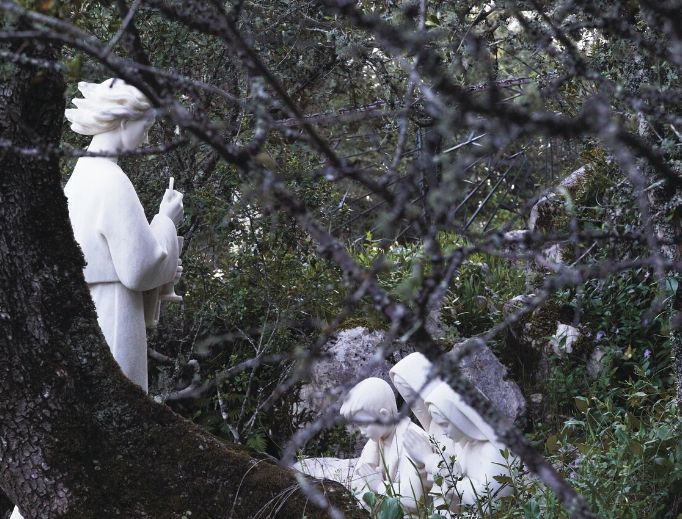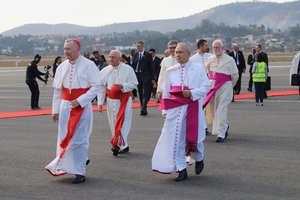Fatima’s Lessons for Our Time of Eucharistic Famine
Our Lady of Fatima brought us vital lessons about the Blessed Sacrament.

When St. Jacinta, one of the Fatima seers, was in the hospital dying from the 1918-1920 influenza pandemic and its complications, her cousin Lucia, another seer, brought her a picture of the Blessed Sacrament. “It is the Hidden Jesus,” Jacinta exclaimed. “I love him so much. If only I could receive him in church.” She was “so grieved to be unable to receive Communion in reparation for the sins committed against the Immaculate Heart of Mary.” Other than the Precious Blood she received from the Fatima Angel in 1916, she never was able to make her first Holy Communion.
Today, with public Masses suspended, Fatima can teach us much as we also grieve our current Eucharistic famine. Father Jeffrey Kirby, pastor of Our Lady of Grace parish in Indian Land, South Carolina, speaker and author, explained that St. Jacinta’s powerful witness when she couldn’t receive Holy Communion and offered this abstinence in reparation for sin “teaches us that even an inability to receive Holy Communion can offer us powerful graces. We should not allow ourselves to fall into a spiritual malaise and miss the powerful grace that is being placed at our disposal. St. Jacinta’s entire life shows us that suffering, including a forced Eucharistic abstinence, comes with a spiritual power to bring about a greater good.” Father Kirby spoke of how the children were always offering up their sufferings, adding that “we can offer for the sins committed against the Holy Eucharist in recent years” our current suffering.
Our Lady of Fatima brought us vital lessons about the Eucharist.
“Mary is a ‘woman of the Eucharist’ in her whole life,” wrote the “Fatima pope,” St. John Paul II, in Ecclesia de Eucharistia. “If the Church and the Eucharist are inseparably united, the same ought to be said of Mary and the Eucharist.”
Our Lady made the Holy Eucharist a major part of Lucia, Jacinta and Francisco’s preparation for her apparitions when, in 1916, the Angel of Peace appeared, holding a chalice with a Host suspended in the air over it. Drops of blood fell from the Host into the chalice.
Leaving the chalice and Host suspended in the air, the angel knelt and had the children repeat three times: “Most Holy Trinity, Father, Son and Holy Spirit, I adore you profoundly, and I offer you the most precious Body, Blood, Soul and Divinity of Jesus Christ, present in all the tabernacles of the world, in reparation for the outrages, sacrileges and indifferences by which He Himself is offended. And, through the infinite merits of His Most Sacred Heart, and the Immaculate Heart of Mary, I beg of You the conversion of poor sinners.” Then the angel gave the Host to Lucia and Precious Blood to Jacinta and Francisco, saying, “Eat and drink the Body and Blood of Jesus Christ terribly outraged by the ingratitude of men. Make reparation for their crimes and console your God.”

Fast-forward to 2019, when a Pew Research poll revealed only 31% of Catholics believe the Eucharist is the real Body and Blood of Christ. The other 69% of Catholics no longer believe that.
“The Angel of Fatima, in giving the shepherd children their first Holy Communion, showed us the heights of the glory that are contained and given to us through our reception of Holy Communion,” Father Kirby told the Register. “If we receive such an all-holy gift in an unworthy state, then we sacrilege the gift and kill the spiritual life of our souls. Our Lady of Fatima warned against a sacrilegious reception of Holy Communion.”
So did St. Paul; in the First Letter to the Corinthians (11:27-32), Paul taught that “we should always receive Holy Communion in a worthy manner. He exhorts us that if we receive the Eucharist in an unworthy way, then we eat and drink condemnation upon ourselves.”
Paul, he notes, made clear to them that many were physically sick because of their unworthy reception of Holy Communion.
“At Fatima, Our Lady warned us about the consequences of abandoning God, dismissing prayer and receiving Holy Communion in a sacrilegious manner,” Father Kirby explained. Father Kirby sees this time of Eucharistic abstinence as an opportunity to heed Our Lady of Fatima’s call to prepare well and to receive worthily the heavenly gift of Holy Communion and to remember that confession is one of the requirements of the First Saturdays devotion.
“The Five First Saturdays emphasize the power of Holy Communion when it’s received in a state of grace,” he said. “The current pandemic, and the forced abstinence from Holy Communion, is a time for everyone to do a spiritual reboot of their understanding of what it means to receive the Bread of the Angels, the Cup of Salvation, the very Body and Blood of Jesus Christ, God-Man and Savior of the World.”
This famine from the Eucharist is also “a time to accuse ourselves of being dismissive, distracted and overly casual in our reception of Holy Communion,” Father Kirby emphasized. “Now is the time to fan into flame the graces of God within us and to make firm resolutions to regularly go to confession, frequently pray the Rosary, and take other spiritual measures to always receive Holy Communion in a worthy and reverent manner.”
Fatima’s appeal continues into our day. “As we see the sufferings caused by our current pandemic, and the abstinence from Holy Communion that’s caused by it,” Father Kirby said, “we all have an opportunity to reform our lives and to deepen our adoration of the Blessed Sacrament and our reception of Holy Communion. We have the possibility to offer up the graces of our day and to ask for God’s protection and blessing upon us all.”
Look to the three Fatima seers, who were models of devotion to Jesus in the Eucharist. During St. Francisco’s final illness, he said what hurt him most was that he couldn’t go to the church “and stay awhile with the Hidden Jesus” — he loved to spend countless hours before the tabernacle consoling Jesus in the Eucharist.
In 1919, 11-year-old Francisco died peacefully, despite suffering terribly from the influenza epidemic of 1918. His great wish of receiving Jesus in the Holy Eucharist was granted the day before he died. Although he had received from the chalice the angel offered him in 1916, this Communion before death was his first Holy Communion. With his devotion to the Blessed Sacrament, and having died on the day after he received his First Holy Communion, Francisco might even be thought of as a saint of the Eucharist and a model for our own reception of the Eucharist once churches reopen for public Masses. When that day comes, Father Kirby prays that “each of us will be ready.”
Joseph Pronechen is a Register staff writer.
He is the author of The Fruits of Fatima.

















